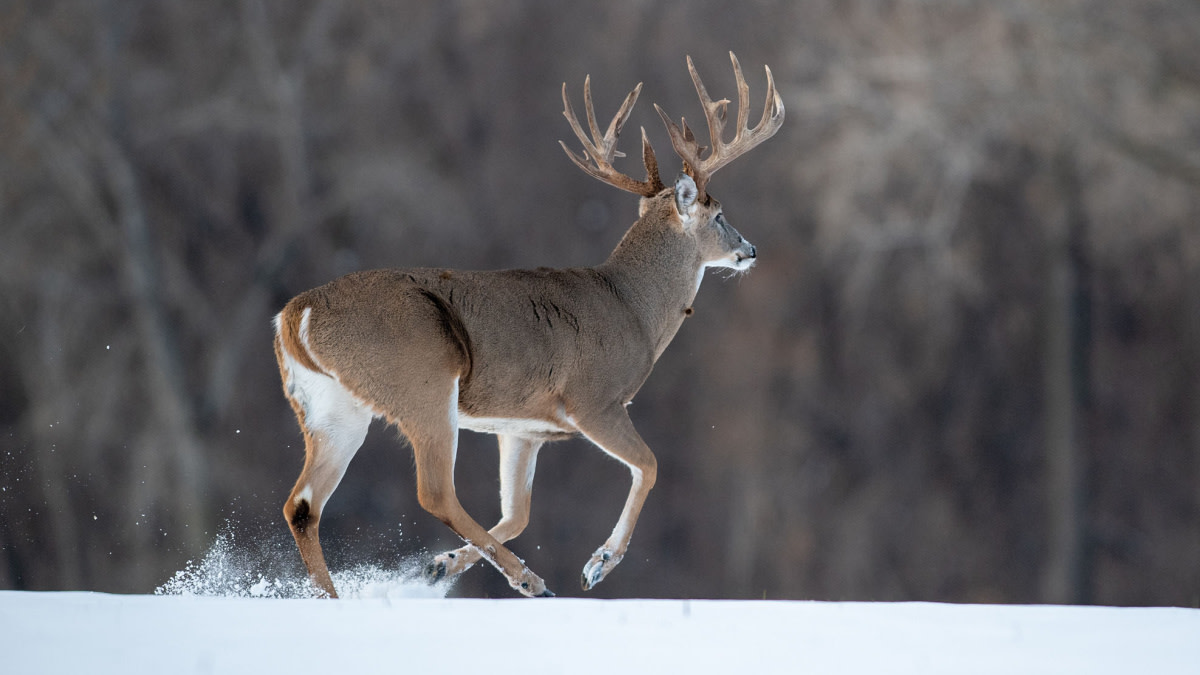
When there’s snow in the forecast during hunting season, you can bet I’ll be heading to the whitetail woods. That’s for one simple reason: Snow shows deer patterns like a black light exposes invisible ink. Tracks are what tell the story.
Whether it be to follow a buck on foot or verify the presence of mature deer in the area, being able to accurately pick out a big buck track in snow is an important skill for any savvy whitetail hunter. Here’s exactly how to do it.
The Track
The first step in identifying a big buck track in snow is to get a look at an undamaged walking print with the hoof and dewclaws clearly discernible. This alone provides an important starting point for determining what type of deer made it. According to Hal Blood, a guide and deer tracker from Maine, the size of your average big buck track can vary by area, so it’s important to learn what’s large in your region. For example, Blood looks for a 3-inch by 3-inch hoof print in his hunting grounds of the Northeast. Whitetails in the Midwest will throw a similar print, but expect to see smaller tracks as you get further west.
The next characteristic to identify is the dewclaw marks found behind the hooves. “A mature buck is going to have the dewclaws set quite a bit back from the back of the hoof, say 2 inches or more,” Blood said. “And they’ll usually be a little wider than the hoof and turned more perpendicular, while a doe will be almost in line.”
Supplemental Clues
Track size isn’t the only factor that matters in a snowy hoof print. For example, the width of a deer’s gait can offer some key insight. “Up here, I look for a deer that has 8 to 12 inches side to side,” Blood said. “Twelve inches is a real good one.”
To measure this, Blood looks at the distance between the center of the left print and the center of the right print. The wider the measurement, the bigger the deer.
Blood also puts a lot of stock into how high the deer picks up its legs as it walks through the snow. “If you see drag marks in an inch or two of snow, that’s a mature buck,” Blood said. “They just get lazier as they get older and don’t pick their feet up as much.”
A final sign to look for in snow are tine marks. These are often left when a buck puts his head down to feed or smell the ground. If you can identify the outside marks left by main beams or tines with a significant width between the two, it can provide a general sense of buck maturity
A final consideration, according to at least one tracking expert, is the actual path that a deer’s tracks follow. Todd Havel, a Midwestern hunter specializing in tracking deer, believes this information is as crucial as any other.
“A big buck walks through the country a lot differently than a doe or a young buck,” Havel said on episode 271 of the Wired to Hunt Podcast. “A big buck almost always takes the easiest route. If there’s a tree leaning, he won’t duck underneath it or jump over it. He’ll go around it.”
Havel contends that big bucks know the most convenient, safe routes. If it appears that a trail is too exposed or ignores the wind, it’s likely not from a mature whitetail.
Experience
While all of the above can point you in the right direction, real life experience is still necessary to develop any confidence in your ability to interpret deer tracks in snow. But one simple exercise can help speed up the process.
If you happen to capture a mature buck on trail cam in fresh snow, locate the track from that deer. Take time to study it. Maybe even photograph it and backtrack the deer to look at how it moved through terrain and how its tracks looked in different scenarios.
The same exercise can be applied any time you see a big buck. If you’re not worried about spooking that deer, or if it’s out of season, walk him down and examine the sign he left behind. There’s a story written in the snow just waiting for you to read it.
Feature image via Matt Hansen.




